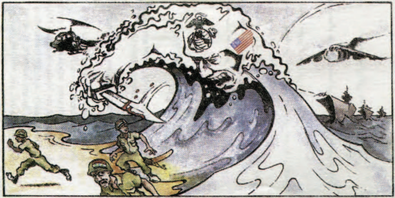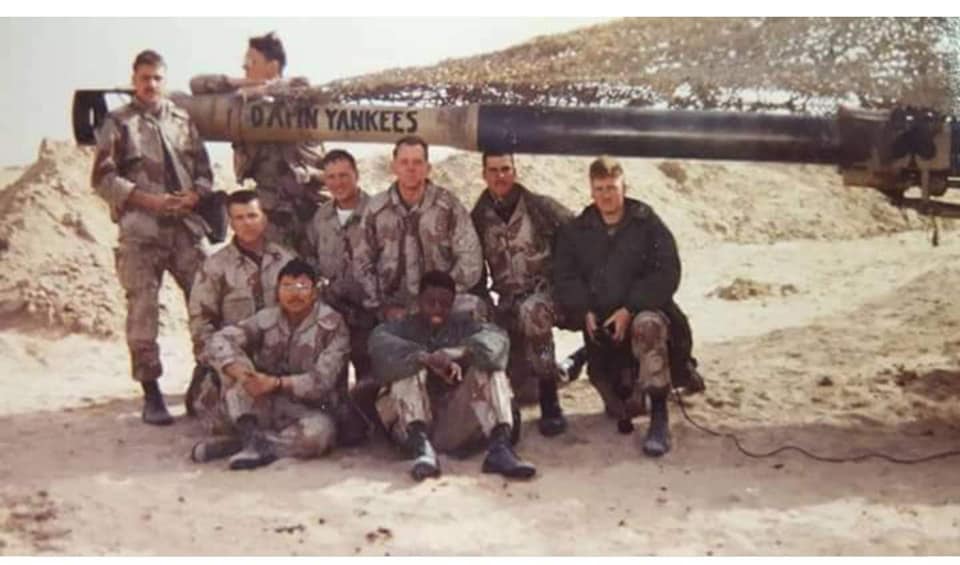By Kater Miller, NMMC Outreach Curator
January 21, 2021
First ground-oriented combat action of Operation Desert Storm
Today marks the 30th Anniversary of Marine Corps ground combat troops firing in support of Operation Desert Storm. F Battery, 2d Battalion, 12th Marines fired at an Iraqi military formation early in the morning of January 21st. It was the first of twelve artillery raids that the Marines conducted against the Iraqi Army in Kuwait. The Marines that performed the raids paved the way for the ground assault that began the following month.
January 21, 2021
First ground-oriented combat action of Operation Desert Storm
Today marks the 30th Anniversary of Marine Corps ground combat troops firing in support of Operation Desert Storm. F Battery, 2d Battalion, 12th Marines fired at an Iraqi military formation early in the morning of January 21st. It was the first of twelve artillery raids that the Marines conducted against the Iraqi Army in Kuwait. The Marines that performed the raids paved the way for the ground assault that began the following month.
 This leaflet warns the Iraqis stationed on the Kuwaiti coast about the threat that the Marines floating in the Persian Gulf pose. These leaflets were part of the deception campaign that kept the Iraqi Army from leaving the coast and reinforcing the obstacle belt. Courtesy of Marine Corps History Division
This leaflet warns the Iraqis stationed on the Kuwaiti coast about the threat that the Marines floating in the Persian Gulf pose. These leaflets were part of the deception campaign that kept the Iraqi Army from leaving the coast and reinforcing the obstacle belt. Courtesy of Marine Corps History Division Planning the Offensive
U.S. Army General Norman Schwarzkopf, U.S. Central Command commander and commander of Coalition Forces for Operation Desert Storm, assigned the Marines to attack Iraqi forces in Kuwait. Saddam Hussein’s troops had constructed two obstacle belts that stretched from the Persian Gulf through Kuwait into Iraq and covered them with several dug-in infantry divisions. He intended for the obstacle belts to slow Coalition forces down and turn the war into a grinding, bloody stalemate. Saddam also believed that his entrenched forces were sufficiently protected from Coalition airstrikes that they could endure the anticipated pre-attack bombardment and still fight the Coalition to a standstill.
Marines knew that the Iraqi Army, one of the largest in the world at the time, would be well entrenched. Iraq had just completed a bloody war against Iran where they had defeated massed Iranian attacks using similar fortifications. The Marines also knew that the air campaign would not destroy the bulk of the forces defending the obstacle belts. To evict the Iraqi Army from Kuwait, the 1st and 2d Marine Divisions would have to punch through these belts while under intense fire. If the Iraqis knew where the Marines planned to breach the obstacle belts, they might have reinforced the area. The Marines conducted a series of deception campaigns to keep the Iraqis guessing where the ground assaults would occur. One of the deception campaigns was staging an amphibious feint off of the coast of Kuwait. The other campaign would feature Marine artillery strikes against Iraqi targets within the obstacle belt fired from different locations at the Kuwaiti border. Another component featured a psychological operation featuring Marines with loudspeakers broadcasting anti-Saddam messages over the border and leaflet drops on Iraqi military positions to encourage defections.
U.S. Army General Norman Schwarzkopf, U.S. Central Command commander and commander of Coalition Forces for Operation Desert Storm, assigned the Marines to attack Iraqi forces in Kuwait. Saddam Hussein’s troops had constructed two obstacle belts that stretched from the Persian Gulf through Kuwait into Iraq and covered them with several dug-in infantry divisions. He intended for the obstacle belts to slow Coalition forces down and turn the war into a grinding, bloody stalemate. Saddam also believed that his entrenched forces were sufficiently protected from Coalition airstrikes that they could endure the anticipated pre-attack bombardment and still fight the Coalition to a standstill.
Marines knew that the Iraqi Army, one of the largest in the world at the time, would be well entrenched. Iraq had just completed a bloody war against Iran where they had defeated massed Iranian attacks using similar fortifications. The Marines also knew that the air campaign would not destroy the bulk of the forces defending the obstacle belts. To evict the Iraqi Army from Kuwait, the 1st and 2d Marine Divisions would have to punch through these belts while under intense fire. If the Iraqis knew where the Marines planned to breach the obstacle belts, they might have reinforced the area. The Marines conducted a series of deception campaigns to keep the Iraqis guessing where the ground assaults would occur. One of the deception campaigns was staging an amphibious feint off of the coast of Kuwait. The other campaign would feature Marine artillery strikes against Iraqi targets within the obstacle belt fired from different locations at the Kuwaiti border. Another component featured a psychological operation featuring Marines with loudspeakers broadcasting anti-Saddam messages over the border and leaflet drops on Iraqi military positions to encourage defections.


 RSS Feed
RSS Feed







